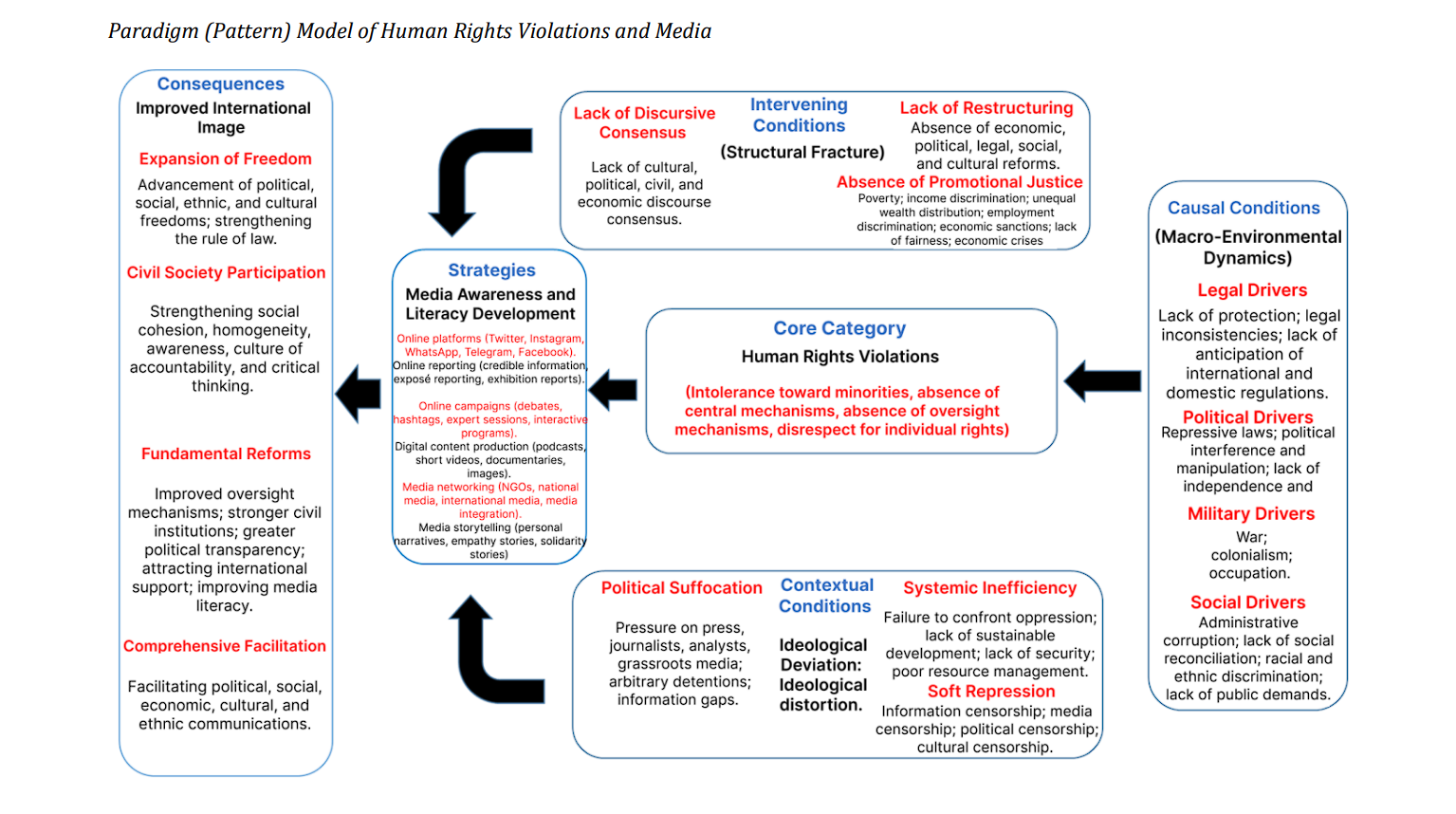Developing a Media Model for Mitigating the Consequences of Human Rights Violations in Iraq
Keywords:
media model, media awareness, human rights violations, consequences, IraqAbstract
This study aimed to identify the dimensions and components of a media model for mitigating the consequences of human rights violations in Iraq. Data were comprehensively collected from Iraq’s media and social platforms, and the analyses were conducted considering the country’s specific sociopolitical context. The central research question was: What are the dimensions and components of an effective media model to reduce the consequences of human rights violations in post-Saddam Iraq? The study employed a qualitative, exploratory research design using the grounded theory approach. The statistical population consisted of faculty members from Iraqi universities specializing in media, communication, human rights, international relations, and political science in 2024. A sample of 13 participants was selected using purposive sampling and based on the principle of theoretical saturation. Data were collected through semi-structured interviews and analyzed using three-stage coding (open, axial, and selective coding). The findings resulted in a model comprising six main categories: causal conditions (macro-environmental dynamics; legal drivers, political drivers, military and social drivers), contextual conditions (ideological deviation; systemic inefficiency, soft repression, political suffocation), intervening conditions (structural fracture; lack of restructuring, absence of promotional justice, lack of discursive consensus), strategies (media awareness and development of media literacy; online platforms, online reporting, online campaigns, digital content production, media networking, media storytelling), consequences (improvement of international image; promotion of freedom, enhancement of civil society participation, fundamental reforms, and facilitation of comprehensive capacity-building), and the core category (human rights violations; intolerance toward minorities, lack of central mechanisms, absence of oversight mechanisms, and disrespect for individual rights). The results indicated that media, as an influential bridge between public opinion and social and political institutions, plays a crucial role in shaping human rights discourse and fostering societal transformation.
Downloads
References
Abbasi Ashlaghi, M., & Norouzi Firouz, R. (2018). The Role of Media in Developing Human Rights Norms in the Age of Globalization. News Sciences Quarterly(27), 49-66.
Al-Dulaimi, S. (2020). Human rights challenges in Iraq's post-2003 governance. Baghdad University Press.
Al-Khafaji, I. (2004). Tormented by history: Nationalism in the Middle East. Verso. https://doi.org/10.5040/9780755621026
Alizadeh, H., Nikkhah, R., Javadi, M. H., & Seyyed Esfahani, S. H. (2024). The Security Council: From a Confrontation of the Guardians of International Peace and Security to Violators of Human Rights. Scientific Quarterly of Islamic Human Rights Studies, 13(3), 61-78.
Alquraan, S., & Aduse, H. (2022). The Role of social mediain Creating Human Rights Culture Among Jordanian University Students. Jordanian Journal of Law and Political Science, 14(1). https://doi.org/10.35682/jjlps.v14i1.342
Amani, M., Beygi, J., & Pourghahramani, B. (2023). The Violation of Fundamental Human Rights with New HAARP Technology. Bi-quarterly Journal of New Technologies Law, 4(7).
Amnesty International. (2002). Iraq: Systematic repression.
Amnesty International. (2015). "Absolute impunity": Militia rule in Iraq.
Amnesty International. (2016). Escape from hell: Torture and sexual slavery in Islamic State captivity in Iraq.
Azadi, F. (2024). The Development of Human Rights Principles in Public Legal Systems: Challenges and Opportunities. Quarterly Journal of Applied Studies in Social and Sociological Sciences, 8(5).
Baram, A. (1991). Culture, history and ideology in the formation of Ba'thist Iraq, 1968-1989. Macmillan. https://doi.org/10.1007/978-1-349-21243-9
Batatu, H. (1978). The old social classes and the revolutionary movements of Iraq. Princeton University Press.
Bloomfield, A. (2016). Norm Antipreneurs and Theorising Resistance to Normative Change. Review of International Studies, 42(2), 310-333.
Bozorgmeheri, M., & Kia Rostami, M. (2017). The Violation of Human Rights through Terrorist Actions and the Mechanism to Combat It. Quarterly Journal of Global Politics, 6(1).
Brutger, R., & Strezhnev, A. (2017). International Disputes, Media Coverage, and Backlash Against International Law.
David, Y., & Shalhoub-Kevorkian, N. (2022). Racializing human rights: political orientation, racial beliefs, and media use as predictors of support for human rights violations - a case study of the Israeli-Palestinian conflict. Ethnic and Racial Studies, 46(10). https://doi.org/10.1080/01419870.2023.2166792
Dawisha, A. (2009). Iraq: A political history from independence to occupation. Princeton University Press.
Foucault, M. (1980). Power/Knowledge: Selected Interviews and Other Writings. Pantheon Books.
Fraser, N. (1999). Rethinking the public sphere:a Contribution to the critique of actually existing democracy. New York: Routledge.
Gholizadeh, A. (2023). Human Rights Violations in Cyberspace. Fourth National Conference on Cyber Defense, Maragheh.
Haj Mohammadi, M. (2022). The Functions of Social Networks in Preserving and Upholding Human Rights. Legal Studies Quarterly(28), 131-146.
Hosseini, S. M., & Rahayi, S. (2024). Due Diligence, a Criterion at the Heart of the International Human Rights System. Human Rights Journal, 19(1), 53-78.
Human Rights, W. (1993). Genocide in Iraq: The Anfal campaign against the Kurds.
Human Rights, W. (2020). Iraq: Deadly response to protests.
International Crisis Group. (2020). Iraq's protest movement: From slogans to strategy.
Isakhan, B. (2015). Democracy in Iraq: History, politics, discourse. Routledge. https://doi.org/10.4324/9781315576411
Isakhan, B. (2020). Democracy in Iraq: History, politics and discourse. Routledge.
Iyengar, S., & Kinder, D. R. (1987). News That Matters: Television and American Opinion. University of Chicago Press.
Kalkali, I., & Raeisi Sha'ar, A. (2019). The Role of Mass Media in the Development of Human Rights. Second National and First International Conference on Law and Political Sciences, Ardabil.
Makiya, K. (1998). Republic of fear: The politics of modern Iraq. University of California Press. https://doi.org/10.1525/9780520921245
McQuail, D. (2010). McQuail's Mass Communication Theory. Sage Publications.
Norris, P. (2010). Public Sentinel: News Media and Governance Reform. World Bank Publications. https://doi.org/10.1596/978-0-8213-8200-4
Rawls, J. (1971). A Theory of Justice. Harvard University Press. https://doi.org/10.4159/9780674042605
Rostami Khorasgani, A. (2021). The Relationship between Media Law and Human Rights. First International Conference on Law and Human Sciences Knowledge and Technology of Iran, Tehran.
Shayanfar, S. (2023). Sanctions and the Violation of Human Rights from the Perspective of International Law, with an Emphasis on Unilateral Sanctions Against Iran. Scientific Quarterly of Islamic Human Rights Studies, 12(4), 139-160.
Shoja, A., Sabernezhd Alavian, A., & Soltani, H. (2023). The Phenomenology of the Violation of Fundamental Human Rights by the Performance of Authoritarian States in Cyberspace. Quarterly Journal of Cyberspace Legal Studies, 2(2).
Shukri Bafragerd, M. (2023). Human Rights Violations, Genocide, War Crimes, and the Use of Unconventional Weapons in Gaza. Seventh International Conference on Jurisprudence, Law, Psychology, and Educational Sciences in Iran and the Islamic World, Tehran.
Tripp, C. (2007). A history of Iraq. Cambridge University Press. https://doi.org/10.1017/CBO9780511804304
United Nations Assistance Mission for Iraq. (2021). Report on human rights in Iraq.
United Nations Assistance Mission for Iraq, & Office of the High Commissioner for Human Rights. (2019). Human rights special reports on Iraq.

Downloads
Additional Files
Published
Submitted
Revised
Accepted
Issue
Section
License
Copyright (c) 2025 Suzan Mehdi Fayyad Al-Shammari, Ali Jafari, Aysar Khaleel Ibrahim, Mojtaba Aghajani (Author)

This work is licensed under a Creative Commons Attribution-NonCommercial 4.0 International License.





